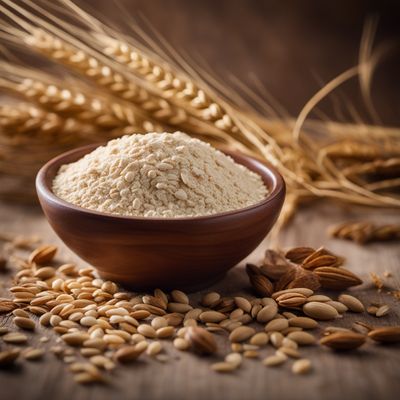
Ingredient
Rice flour
The Versatile Grain Powder
Rice flour is a fine, powdery substance made by grinding rice grains into a smooth texture. It has a mild, slightly sweet flavor and a soft, silky texture. Rice flour is commonly used in gluten-free baking, as a thickening agent, or as a coating for fried foods.
Origins and history
Rice flour has been a staple in Asian cuisines for centuries, particularly in countries like China, Japan, and India. It is believed to have originated in East Asia and spread to other regions over time. Rice flour has played a significant role in traditional Asian dishes, such as rice noodles, dumplings, and desserts. Today, it is widely consumed and appreciated in various global cuisines.
Nutritional information
Rice flour is naturally gluten-free and contains essential nutrients such as carbohydrates, protein, and small amounts of vitamins and minerals. It is also low in fat and cholesterol, making it a suitable choice for individuals with dietary restrictions or specific health concerns.
Allergens
Rice flour is free from common allergens like gluten, wheat, and nuts, making it a safe option for individuals with food allergies or intolerances. However, cross-contamination may occur during processing, so it is essential to choose certified gluten-free rice flour if necessary.
How to select
When selecting rice flour, opt for finely ground varieties that have a smooth texture and a bright white color. Avoid flour that appears clumpy or has a yellowish tint, as this may indicate poor quality or improper storage. Additionally, consider the specific type of rice used to make the flour, as different varieties can impart slightly different flavors and textures to the final dish.
Storage recommendations
To maintain the freshness and quality of rice flour, store it in an airtight container in a cool, dry place, away from direct sunlight. This will help prevent moisture absorption and the development of mold or insects. Properly stored rice flour can last for several months, but it is best to check the expiration date on the packaging for specific guidelines.
How to produce
Rice plants require warm temperatures and ample water to grow successfully. They are typically cultivated in flooded paddy fields, where the water helps control weeds and pests. Growing rice at home may not be practical for most individuals, as it requires a large amount of space and specific growing conditions. However, some varieties of rice can be grown in containers or small gardens, provided they receive sufficient sunlight and water.
Preparation tips
Rice flour can be used in a variety of dishes and recipes. It is commonly used as a thickening agent in soups, sauces, and gravies. In baking, rice flour is often used as a substitute for wheat flour in gluten-free recipes, such as cakes, cookies, and bread. It can also be used as a coating for fried foods, providing a crispy texture. Additionally, rice flour is a key ingredient in traditional Asian dishes like rice noodles, dumplings, and pancakes.
Substitutions
Cornstarch or potato starch can be used as substitutes for rice flour in recipes that require thickening. However, keep in mind that these alternatives may alter the texture and flavor of the final dish. For gluten-free baking, a combination of different flours like tapioca flour, almond flour, or coconut flour can be used instead of rice flour.
Culinary uses
Rice flour is widely used in Asian cuisines, particularly in dishes like rice noodles, dumplings, and desserts. It is also a popular choice for gluten-free baking and can be found in various recipes for cakes, cookies, and bread. Additionally, rice flour is used as a coating for fried foods to achieve a crispy texture.
Availability
Rice flour is commonly available in grocery stores, Asian markets, health food stores, and online retailers. It is cultivated and consumed in many countries worldwide, with significant production in Asia, particularly in China, India, Thailand, and Japan.
More ingredients from this category » Browse all

Maize, milled
Golden Grain: Unleashing the Power of Milled Maize

Oat flour
The Wholesome Power of Oat Flour

Wheat flour
The Versatile Grain: Exploring the Wonders of Wheat Flour

Spelt flour
The Ancient Grain of Spelt

Cereal and cereal-like flours not separately listed
The Flour Power: Unleashing the Versatility of Cereal and Cereal-Like Flours

Buckwheat flour
The Nutty Powerhouse: Buckwheat Flour

Rye flour
Hearty Grain

Millet flour
The Ancient Grain: Millet Flour

Flour mix (like wheat/rye/barley/oats and other)
Versatile Blend for Every Recipe

Barley flour
The Nutritional Powerhouse: Barley Flour

Amaranth flour
The Ancient Grain Flour with a Nutty Twist

Sorghum flour
Sorghum Flour: A Nutritious and Gluten-Free Alternative
Recipes using Rice flour » Browse all

Assamese-style Rice Flour Doughnuts
Puffed Rice Flour Delights: Assamese-style Doughnuts

Chinese Aristocrat Mushroom Velouté
Silken Mushroom Elixir: A Chinese Aristocrat Delight

Bánh chuối with a North East Indian Twist
Spiced Plantain Fritters: A Fusion of Vietnamese and North East Indian Flavors

Saraiki-style Kushiage
Crispy Delights from the Heart of Saraiki Cuisine

Sanna with a Pakistani Chinese Twist
Spicy and Tangy Sanna: A Fusion Delight

Telugu-style Vegetable Pasteles
Spiced Veggie Parcels: A Telugu Twist on Puerto Rican Pasteles

Crispy Duck's Head with Spicy Szechuan Sauce
Szechuan Delight: Crispy Duck's Head with a Fiery Kick

Spicy Korean Squid Stir-Fry
Fiery Delight: Spicy Korean Squid Stir-Fry

Vietnamese-style Fish and Chips
Crispy Fish with a Vietnamese Twist

Ika Nigiri Sushi
Ocean Delight Nigiri Sushi

Beef & Broccoli Nouvelle Cuisine
Elevated Beef & Broccoli Delight

Qiang Lianhuabai Stir-Fried Lotus Root with Spicy Sauce
Fiery Lotus Dance: Spicy Stir-Fried Lotus Root